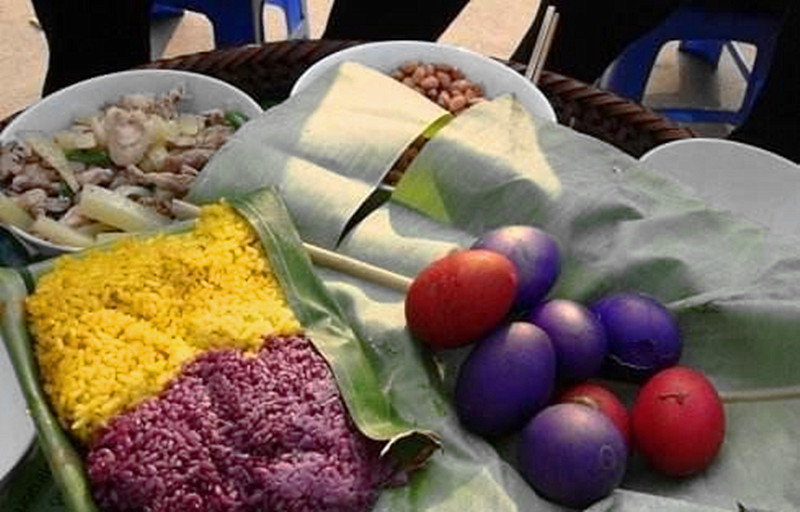 alt="Puer Surrounding Counties and Towns: Weekly & Special Local Markets Travel Guide"
/>
alt="Puer Surrounding Counties and Towns: Weekly & Special Local Markets Travel Guide"
/>
Limazhu Festival of Hani Ethnic Minority
The Basic Introduction of the Festival
Chinese Name: 哈尼族里玛主节/黄饭节/开秧门节
English Name: Limazhu Festival of Hani Ethnic Minority
The Lijia (Li Mazu) Festival is a traditional holiday of the Hani ethnic group, celebrated in each year during the blooming of camellias in the sunny month of March. The Hani people living by the banks of the Honghe River have a deep affection for the cuckoo bird, which they refer to as “Habo Amama” (Cuckoo Mother).
The term “Li Mazu” comes from the Hani language and means “the grand gathering of spring.” It is also known as the Huangfan Festival or the Opening Rice Seedling Gate Festival, and is a traditional holiday of the Hani people in the Honghe region of Yunnan, held on the day of the Goat in the lunar calendar, lasting for one day. This festival is closely related to the Hani people’s admiration for the cuckoo bird.
The Hani people worship the cuckoo and respectfully call the spring-singing cuckoo “Hebo Amama” (Cuckoo Mother). When the camellias bloom, anyone who hears the cuckoo’s call for the first time is expected to respond with “I heard it!” to celebrate the arrival of spring. Folklore holds that this response can ensure a bountiful harvest and prosperous livestock for the year, along with safety and good health.
Each year, upon hearing the call of “Hebo Amama,” villages traditionally prepare fine wines and delicious dishes on the Goat day (according to the twelve zodiac animals). They also go into the mountains to pick flowers from a certain tree, extract the flower juice, and soak glutinous rice in it. This results in fragrant steamed glutinous rice and boiled red eggs, which are offered to the cuckoo. After that, villagers gather at the hilltops to sing and dance. Men also engage in wrestling, characterized by moves such as waist grabs, leg tackles, underarms, and leg passes, typically contested in a best-of-three format, with the first to touch both shoulders to the ground being the loser.
The origin of the “Li Mazu” festival is rooted in a legend that recounts how, in ancient times, the cuckoo was dispatched by the heavenly deities to bring the message of spring from afar. As it flew over the ocean, it grew exhausted and was about to fall into the sea. Suddenly, a dragon’s tail emerged, transforming into a great tree, where the cuckoo stopped to rest. Despite facing numerous hardships, the cuckoo successfully brought the news of spring to the human world. The Hani people then planted their spring crops on time as a result of this message, which led to a fruitful harvest. In honor of the cuckoo’s contributions, the festival evolved into a celebrated ethnic holiday over time.
The Local Activities
1. Grasshopper Catching
- Community Gathering: Villagers, including men, women, and children, come together in the fields to catch grasshoppers, a central activity of the festival.
- Techniques and Tools: Participants use simple homemade tools, such as bamboo sticks or nets, to catch grasshoppers. Experienced individuals often share tips and tricks for a successful catch.
2. Celebratory Cooking
- After catching grasshoppers, families prepare traditional dishes featuring their catch. This may include various methods of cooking the grasshoppers, such as frying or stewing, often paired with rice or other staple foods.
3. Cultural Performances
- Songs and Dances: The festival is a time for cultural expression, with villagers performing traditional songs and dances. These performances may include storytelling through dance, often depicting elements of Hani folklore.
- Wrestling Matches: Men participate in friendly wrestling competitions, showcasing traditional wrestling techniques and fostering community spirit.
4. Ritual Offerings
- In honor of the cuckoo bird, which holds a special place in Hani culture, offerings may be made to ensure good fortune and a prosperous harvest. This could involve preparing symbolic foods or conducting rituals to celebrate the arrival of spring.
5. Community Feasting
- At the end of the day, villagers come together for communal meals, sharing the food they have prepared. This fosters a sense of community and strengthens social bonds among participants.
6. Nature Appreciation
- The festival coincides with the blooming of local flowers, and villagers often take time to appreciate and enjoy the beauty of nature. This may include hiking in the surrounding areas or engaging in other outdoor activities.
7. Traditional Games and Competitions
- Various games and competitions may take place, encouraging friendly rivalry among different families or clans. These can include races, skill contests, and other fun activities.
8. Storytelling and Folklore Sharing
- Elders often recount legends and folk stories related to the festival, the harvest, and the importance of the cuckoo bird in Hani culture, helping to pass down traditions and values to younger generations.

 7 Days GolfingTour
7 Days GolfingTour
 8 Days Group Tour
8 Days Group Tour
 8 Days Yunnan Tour
8 Days Yunnan Tour
 7 Days Shangri La Hiking
7 Days Shangri La Hiking
 11 Days Yunnan Tour
11 Days Yunnan Tour
 6 Days Yuanyang Terraces
6 Days Yuanyang Terraces
 11 Days Yunnan Tour
11 Days Yunnan Tour
 8 Days South Yunnan
8 Days South Yunnan
 7 Days Tea Tour
7 Days Tea Tour
 8 Days Muslim Tour
8 Days Muslim Tour
 12 Days Self-Driving
12 Days Self-Driving
 4 Days Haba Climbing
4 Days Haba Climbing
 Tiger Leaping Gorge
Tiger Leaping Gorge
 Stone Forest
Stone Forest
 Yunnan-Tibet
Yunnan-Tibet
 Hani Rice Terraces
Hani Rice Terraces
 Kunming
Kunming
 Lijiang
Lijiang
 Shangri-la
Shangri-la
 Dali
Dali
 XishuangBanna
XishuangBanna
 Honghe
Honghe
 Kunming
Kunming
 Lijiang
Lijiang
 Shangri-la
Shangri-la
 Yuanyang Rice Terraces
Yuanyang Rice Terraces
 Nujiang
Nujiang
 XishuangBanna
XishuangBanna
 Spring City Golf
Spring City Golf
 Snow Mountain Golf
Snow Mountain Golf
 Stone Mountain Golf
Stone Mountain Golf











 What Our Customers Say?
What Our Customers Say?
